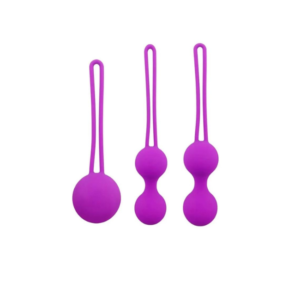In the world of women’s health and wellness there are products that often remain in the shadows. Discussed in hushed tones or dismissed as trivial, one such product that has been gaining traction in recent years is Kegelblasts.
If you’ve never heard of them or are curious about their benefits, we’re here to explore the world of Kegelweights and how they may make a significant difference in women’s lives. To appreciate the significance of Kegelweights, it’s important to understand the role of the pelvic floor muscles.
These muscles shaped like a hammock support the pelvic organs including the bladder, uterus, and rectum. A weak pelvic floor can lead to a range of issues including urinary incontinence, pelvic organ prolapse, and even sexual dysfunction.
One of the biggest reasons your pelvic floor can become weaker is if you’ve had a child. Your body has changed a lot after giving birth and these muscles are in desperate need of exercise. You may use Kegelballs immediately after birth and studies have shown that this will reduce the development of urinary and fecal incontinence from pregnancy to postpartum.
Kegel exercises named after Dr. Arnold Kegel have long been prescribed by healthcare professionals as a non -invasive way to strengthen the pelvic floor. These exercises involve contracting and relaxing the pelvic floor muscles, much like stopping the flow of urine midstream.
However, the challenge with traditional Kegel exercises is that many people find it challenging to identify and isolate the correct muscles. Enter Kegelweights. Kegelblast offers a unique solution to this problem.
These three small weighted devices are inserted into the vagina and provide resistance for the pelvic floor muscles to work again. Start with the lighter weight and move your weight up which may take several weeks.
They come in various shapes and sizes to accommodate different levels of experience and strengthen and may be used for up to six hours a day to achieve best results. However, some say that 10 to 15 minutes a day may be good enough if you are holding and releasing which is contracting.
and then relaxing. It will vary from person to person but I recommend just keep doing the pelvic floor exercises until you feel fatigued. Using Kegel Blast is simple. Choose one that matches your strength level, ensure it’s clean before use, put it in like a tampon.
When you begin inhale and then relax exhaling slowly through your mouth as if you were blowing out a candle. Contract your pelvic muscles to hold it in. Squeeze around your vagina and bladder as if you were stopping the flow of urine or squeezing during intercourse.
Then let go of the muscles. Do this several times and try longer squeezes with increasing the amount of repetitions and do this daily for the best results. Afterwards clean it and put it away. If you don’t have Kegel Blast yet, here is a chart that shows examples of doing Kegels for beginners.
I know there are many solutions for vaginal tightening and urinary incontinence out there including rejuvenation gels and capsules, wands, laser therapy, and even surgery. However, here at Our Doctor we make it simple.
Consider trying Kegelblast as a cheap yet very effective option to strengthen and tighten your pelvic floor. Strengthening the pelvic floor muscles can enhance sexual health in several ways, contributing to improved sexual function and satisfaction.
Strong pelvic floor muscles can enhance sexual sensation during intercourse. These muscles surround the vaginal and anal openings and their strength can lead to greater sensitivity and responsiveness to stimulation.
So don’t be afraid to ask your male partner if he notices the additional sensation during sex. Pelvic floor muscles provide support to the vaginal wasps. Strengthening these muscles can result in improved vaginal tone, which can enhance sexual pleasure for both partners.
Strong muscles can allow for increased muscular contractions during climax, potentially leading to more intense and satisfying orgasms. In some cases, some may experience sexual discomfort or vaginal atrophy, which is pain related to pelvic inflammation, which could be caused by your body producing less estrogen.
Others may experience issues such as muscle tension or spasms. Pelvic floor exercises, including relaxation techniques, can help alleviate this pain and improve sexual comfort. A strong pelvic floor can contribute to better vaginal lubrication, making intercourse more comfortable and enjoyable.
This is particularly relevant for women experiencing vaginal dryness, which can be a common issue during menopause. Women with strong pelvic floor muscles often report feeling more confident in their bodies and their sexual abilities.
Confidence can positively impact sexual desire and overall satisfaction. After pregnancy or childbirth, pelvic floor muscles may become stretched and weakened by up to 30%. Most will experience a weakened pelvic floor muscle, leading to incontinence or prolapse.
Strengthening exercises can aid in postpartum recovery, restoring pelvic health and improving sexual function. It is important to know that even if you had a C -section, your pelvic floor may need tightening from aging or wear and tear.
Pelvic organ prolapse, which can occur when pelvic organs descend into the vaginal area, can affect sexual health and comfort. Strong pelvic floor muscles and abdominal exercises may help prevent this condition, maintaining normal anatomical support.
KegeBlast is a promising addition to the arsenal of tools for women’s health and wellness. As with health -related products, it’s essential to do your research. Consult with your healthcare professional as needed and approach your journey to pelvic floor strength with patience and diligence.
-
Product on sale
 KegelBlast ReusableOriginal price was: $19.00.$16.15Current price is: $16.15.
KegelBlast ReusableOriginal price was: $19.00.$16.15Current price is: $16.15.
If you have any additional questions or comments related to this video, please contact our doctor and we’ll be sure to answer any of your questions. Take care.

